LURTON'S STORE
Commiskey, Jennings County, Indiana
When I was moving I found this article from the
Sunday Indianapolis Star Magazine from July 17, 1966. It must have been sent by
a relative to my parents who were living in California at that time.
The Lurton's store building still stands in Commiskey but it is now closed.
The Lurton's store building still stands in Commiskey but it is now closed.
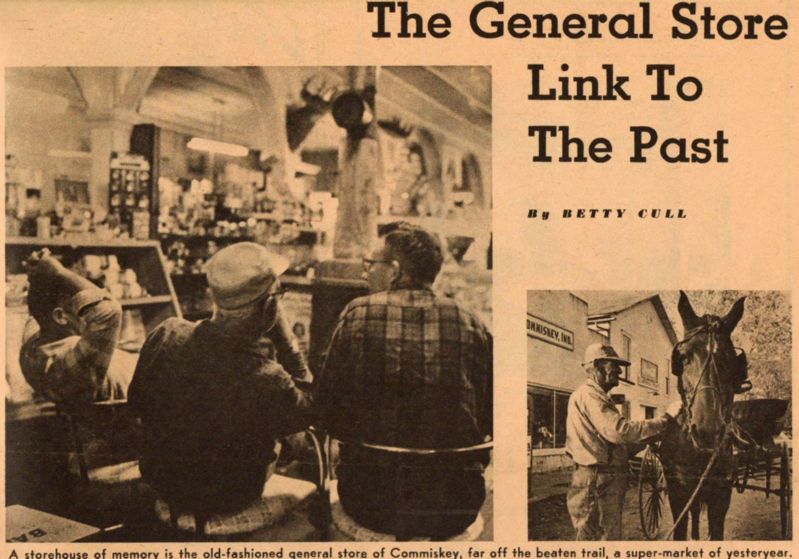
Through the 150 years of Indiana's history as a state perhaps no institution has evoked the fond memories or spanned the time from past to present as had the country store-community forum, social center and market place for the necessities of life.
Of the larger ones, only a few remain. One of these is Lurton's, at Commiskey, Ind., nine miles south of Vernon.
Founded by Dr. Charles F. Lurton in 1881, the store has been operated continually by the Lurton family. When he came to Commiskey, Dr. Lurton moved into a town that had happened by mistake.
A combination of poor brakes and a steep grade had caused a Mississippi & Ohio train, carrying a new station for Sherman's Crossing, to overshoot the village by a mile.
Unwilling to carry the building to Jeffersonville and back, the crew shoved it off into a briar patch near a cabin built by Patrick Commiskey. Within a few weeks, the railroad crew posted a sign "Commiskey" on the station, and it became official.
Soon, Pat donated a tract of land for the town which grew around the station, and the "accident" assumed direction.
Like Commiskey, Dr. Lurton's first store was small, specializing in tinware, buckets, tubs, tincups and similar items. With the town, it was destined to grow. The storekeeper-doctor was a man of many talents, the foremost of which was his practice of medicine. This was carried on principally at the store, where he also received emergency cases.
A long-remembered example of the latter occurred when Gilbert Wilkerson, playing with a hatchet, almost severed two fingers from his brother Sherman's hand. The boy was rushed to Lurton's store.
Dr. Lurton examined the hand, then walked to a small case behind the counter and removed a new pair of scissors from a clutter of hardware pieces.
After sterilizing the sissors in a bottle of alcohol, he calmly pushed back the skin and amputated one finger.
After wrapping the hand, he gave the child a piece of candy, and the operation was over.
Preserved in alcohol, the finger was a topic of conversation in the store for several years.
In addition to physician and storekeeper, the doctor also was a photographer, specializing in tin-types. For these, the store became his studio. Often, when a customer made a purchase at the store or sat for a tin-type, "Doc" entertained him with a song and a banjo number.
This musical talent prompted his attendance at fairs and shows, where he performed. Alert to every business opportunity, he also worked as a photographer at the gatherings. His wife, Mary Katherine, and son Charles F. Lurton Jr., clerked in the store, making these summer forays possible.
Accommodation is the key word in the history of Lurton's store.
It served as Commiskey's first postoffice where mail bags arrived via the Baltimore & Ohio, successor in the O. & M.
The mail was sorted, bagged and carried on the route by deliverymen on horseback. In the early years, one trip was made each week, then it increased to twice weekly.
When the daily papers began to be issued, the couriers rode each day. The Indianapolis Star was the paper carried and their trips soon were known as the Star route. This continued until RFD service was established in 1904. Another symbol of Lurton's service was the peddle wagon which Charles F. Jr. first drove out of Commiskey in 1885.
This huckster route, extending west and south into Scott County, required five days of travel.
In an era when most farm families made one yearly trip to North Vernon or Madison, the peddle wagon brought necessities and some luxuries otherwise impossible to obtain.
It arrived with a distinctive sound as the driver first blew a conch shell and, later, a discarded Civil War bugle, to attract attention. What a sight it presented. Two horses pulled the big, creaking farm wagon with its high top and covered sides.
Attached to the sides were coops for geese, chickens and turkeys which were bought at the farms. In the cold months rabbits, too, were available, often priced at 10 cents each. These were piled inside.
Beside the driver, stood the butter barrel. Into it the farm wife scraped any butter she had made for sale.
In winters, the arrangement was not bad, but dust and heat may have affected the product in the summer.
Eggs, bought from the farm, were piled in large boxes in the center of the wagon. Poultry, eggs and butter furnished the medium of exchange and little money actually changed hands.
A farm wife would order a hen's worth of soft sugar, a rabbit's worth of pepper and exchange eggs for a dress length of calico. The calico was valued at 3 cents per yard.
Barrels of flour, soft sugar (brown), salt and pepper were carried as were the dried fruits, considered a delicacy.
A tank of kerosene stood near the back of the wagon. This area also consisted of a series of shelves stocked with trimmings, dry goods and notions. The hinged shelf cover was lowered to serve as a measuring table where the peddler cut his yard goods and trimmings.
Farm women sewed for the family, and often, in the fall, gought a bolt of factory (muslin) and one of outing. Arbuckle coffee was the only brand available. It was sold in whole bean form either roasted or green, the latter for those who preferred to roast it in their own ovens.
When the peddle wagon returned to the store, eggs were graded and crated, the poultry fed and watered, and all were prepared for shipment on the train.
The butter barrel was emptied and cleaned and the wagon re-stocked. Cherks worked late at night filing orders to go out on the wagon the next day.
The store's name became known afar. At the same time, one member of the Lurton family was known nationally. Burton F. Lurton, brother of Dr. Charles, as an associate justice of the United States Supreme Court.
As Dr. Lurton's health waned, his son assumed more duties at the the store.
In his early teens, Charles F. Lurton Jr. had shown a flair for business. And with typical Lurton versatility, he had learned telegraphy. As Commiskey's first Western Union operator, he added yet another dimension to the store's accommodations. Later he became the town's first railway express agent.
The railroad was Commiskey's avenue of commerce with the outside world, and Lurton's was the center of operation.
Alongside the track, stock pens corralled sheep, beef and hogs. These with eggs, turkeys and poultry of all kinds, were shipped by the carload each week. Loose wheat left Commiskey by the carload at harvest time.
Arriving in carload lots were fencing, roofing, salt, feeds, crockery, tinware and at Christmas, candies and peanuts. Following the Lurton tradition, Charle's wife, Arizona, became a constant help to him in the store and at home.
Family, clerks, hucksters, telegraph operators, traveling salesmen and people awaiting trains were made comfortable at the house, fed at all hours and often entertained overnight.
Always active in community affairs, Charles F.served as school trustee, and was instrumental in organizing the communitiy's first bank. The Citizens Bank drew national attention when, during the failures of 1930, it remained unscathed.
In 1916, Charles F.'s health began to fail. His son Ernest, assumed a good portion of the work, especially concentrating on sale of farm machinery. With his brother Leland, he operated the sotre after their father's death. Leland's death, in 1948, terminated the partnership. While the drive-in movie seems to be a product of recent years, it was thriving, after a fashion, at Lurton's in the 1930s, when the store brought old Western movies and Keystone Cops comedies to Commiskey every week during the summer.
The movie screen was a sheet stretched on a rope from a tree by the store across the street to a telephone pole.
Early on movie night, trucks filled with children, heavily laden cars and a certain number of pedestrians line the town's main street to view the movie.
This crowd brought business to the quaint ice cream parlor which comprised a section of the store. Always, 15 to 30 varieties of ice cream were carried and, on show night, 40 to 60 gallons were sold at the price of three dips for a nickle. In 1937, Ernest married Merylee Ogisby of New Albany. As did the Mrs. Lurtons before her, she joined her husband in the store.
Lurton's store expanded to four times its original size. New electric fixtures supplanted oil lamps and oil heaters were given the job once relegated to the pot-bellied stove.
Self-service gondolas replaced barrels once used for kraut, mackerel, crackers and pickles. Ladies' shorts gradually began to outsell sunbonnets and milk came in glass bottles from the dairy instead of in metal cans from the farm.
The store's stock came to include such varied merchandise as hats for men and boys, suits, dresses, luggage, kerosene, gasoline, motor oil, housewares, hardware, beauty aids, hunting and fishing licenses, seeds, toys, yard goods, notions, baby clothes, meat, groceries and countless other items. As recently as 1958, Lurton's was carrying leather horse collars, bridles and harness.
That link with the past was discontinued when the entire stock was bought by representatives of a Mennonite settlement in the East. Traveling in a large, semi-trailer truck, they were visiting country stores in search of hard to find harness.
The advent of television sets, the one in the store is most used by late afternoon "regulars" who gather back of the store to watch and talk. The World Series and major events attract a few more viewers. Bringing the past to the present, Lurton's store successfully blends the old and the new. Milk pails, wash tubs, bamboo fishing poles and rubber boots are as important as electric appliances, zippers, aerosol sprays and frozen foods. The pleasant profusion of items invites customers to linger and look as they did years ago.
Following the death of her husband this spring. Merylee Lurton has continued operating the store on its usual six days a week schedule, including hours as late as 9 p.m.
With the traditional Lurton interest in community affairs, she has served as president of Psi Iota XI Sorority and is a Home Demonstration Club member. Always active in the Commiskey Baptist Church, she taught Sunday School for 25 years and has served a longer time as church pianist. Through the years, things have changed. Automobiles and highways have replaced the railroad in importance, and Indianapolis seems as near as North Vernon did in the 1890s. Located one mile from Ind. 3, Commiskey and Lurton's sideroad supermarket have settled into a quiet existance.
Inevitably, some day in the future, Merylee will retire. When she does, the door may be closed on this wonderous collection of merchandise and the store's treasure house of memories for the community.
Meanwhile, in a warm atmosphere of yesteryear, the old store serves the village of today.
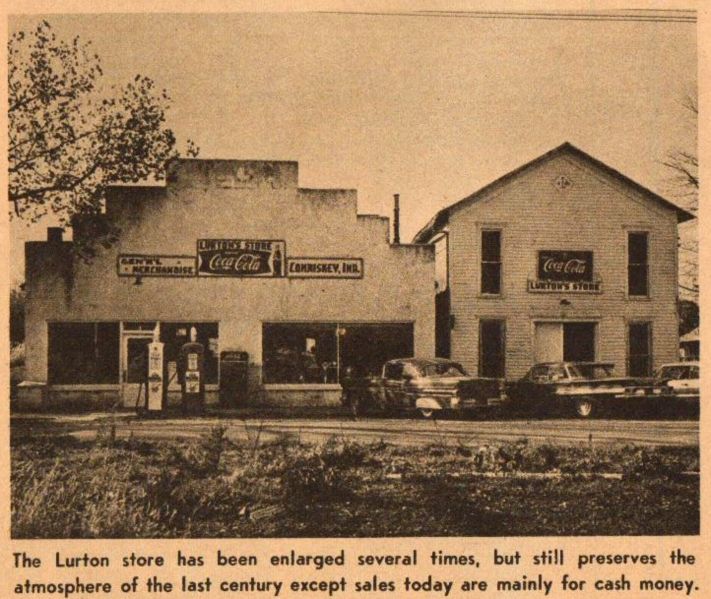

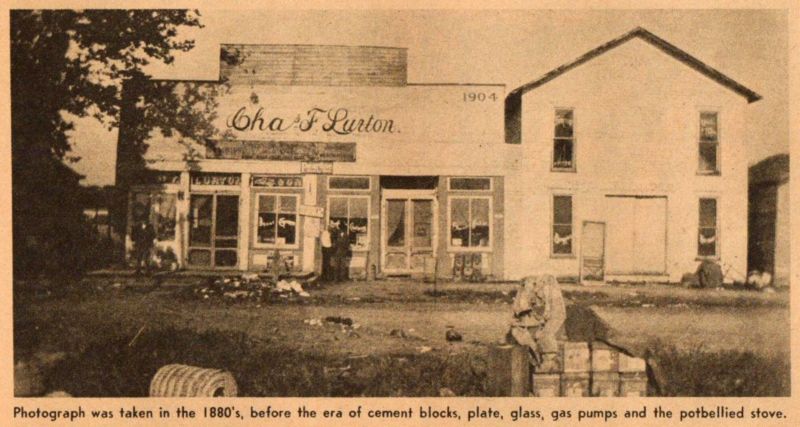
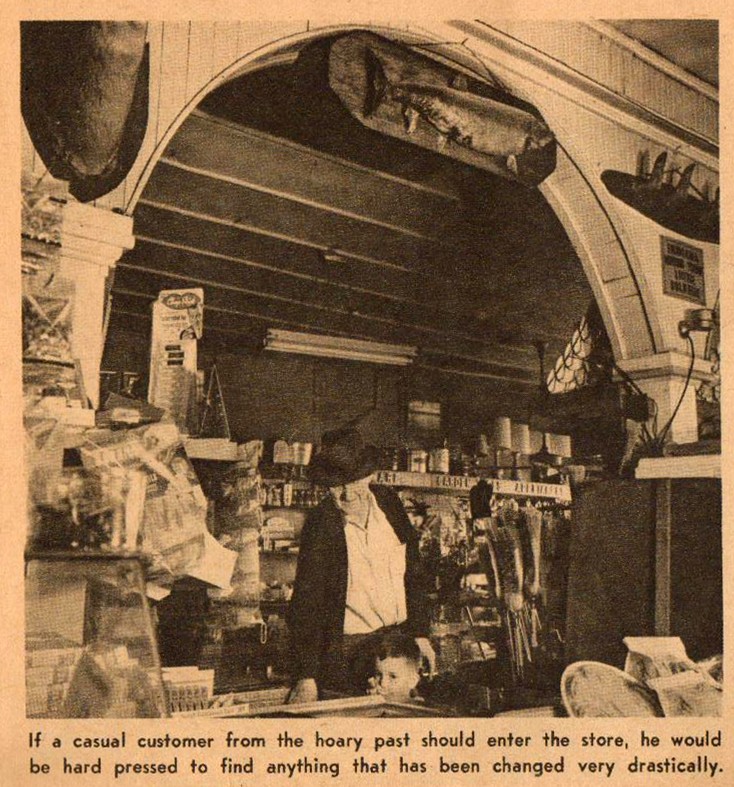
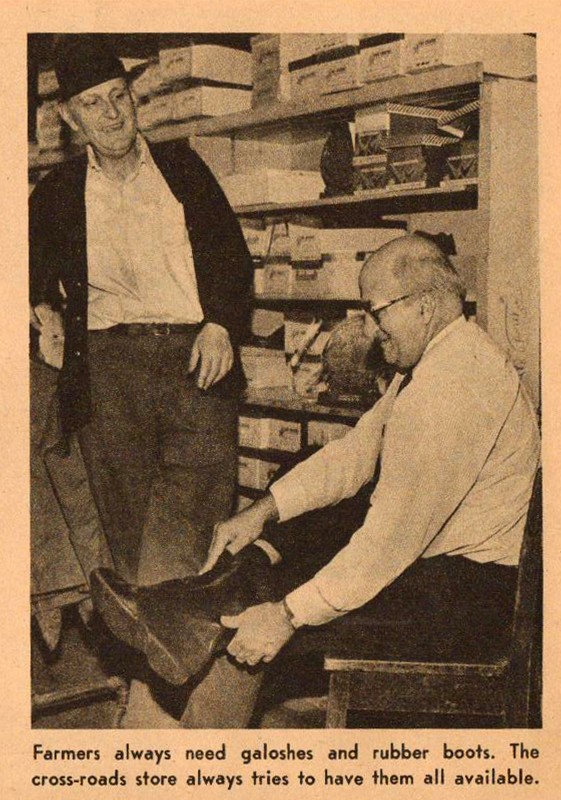

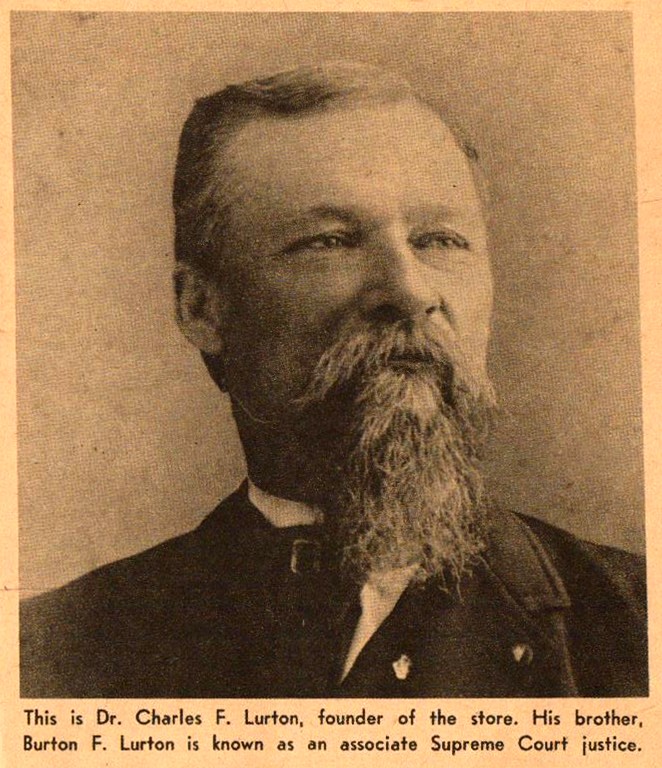
IN MEMORY OF CHARLES F. LURTON
January 24, 1900 - North Vernon Sun
The above picture again calls to mind the face of one of Jennings County's leading citizens. To
know him was to love him. Mr. Lurton was a more than ordinary intellectual ability possessing many traits of character that
made made him strong in the community in which he lived, and whose influence as a public spirited and generous man was known
far and near. He began his business career at Commiskey, in the southern part of this county, during March 1882, at that time
being a stranger to almost every person within the borders of this county. From that time until his demise his acqaintance, like
his business qualifications grew each year until his name was a houshold word in this and adjoining counties. By reason of his
energy and high standing he caused to be established in his home town. Dauntless Lodge Knights of Phthias, and the erection of a
Castle Hall for the use of the members of the Order. From the time of the ladge he remained a true, loyal and devout disciple of
the great principles of friendship and benevolence enacted by Damon and Pythias more than five hundred years before the birth of Christ.We like they, enacted upon the stage of life a precept of devotion which will reflect the search-light of noble manhood over that part of the country in which he lived and died, for many years to come. His name will be recorded in the annals of history of the town of Commiskey, and the lodge of which he died an honored member. Mr. Lurton departed this life at his home on Sunday, the 4th day of June, 1899, being 62 years and 7 months of age, leaving surviving him his son, Charles F. Lurton, Jr., and his widow, Henrietta, who so long as time lasts with them, will ever remember the one who was so near and dear to thm by ties of nature and affection. And the public at large, for years to come, will miss his financial assistance and advice so generously rendered by him during life. During his last illness he suffered excruciating pain by reason of the enlargement of his liver, which caused his death. Being ever mindful of the advancement in science and the welfare of his fellowmen, almost his last request was that the attending physicians hold an autopsy so they might be better prepared to treat others suffering from the same malady that extinguished his mortal career. Around his bier, before consignning his body to mother earth, stood his fraternal brothers, neighbors and friends from far and near. Notably among them being the last survivor of the Independent Fire Company of Louisville, Ky., -Hassan, of which company the deceased was also amember and had been since 1854. Mr. Lurton finished the task alloted him and passed to his superlative reward. From his manly course let us take pattern and imitate the nobility of his nature that made him a prince of men.
To the community in which he lived be left a monument more magnificent and enduring that was ever hewn from granite or stone. Let us emphasize the fact that a character like his a fidelity like his, a beauty of life daily exemplified by him are the imperishable virtues that are obrained by the few and should be dilligently sought by all. G.F.L. (George F. Lawrence)
You may use this material for your own personal research, however it may not be used for commercial publications without express written consent of the contributor, INGenWeb, and